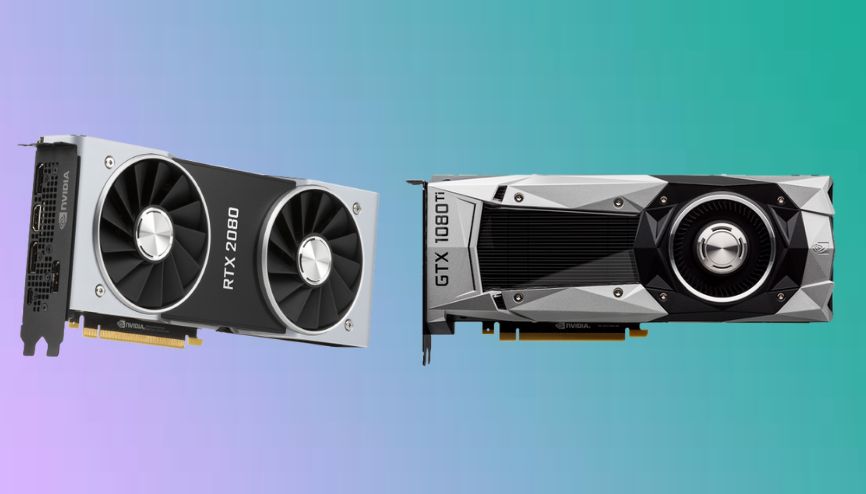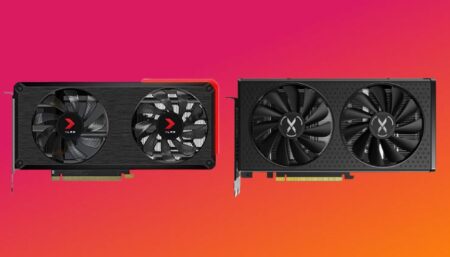
NVIDIA is the best graphic card manufacturer company, and its graphic cards are definitely a top pick for gaming and other productivity. The RTX series is the best of Nvidia’s graphics cards today; it is currently in its second generation (at the time of this post), with a new one just over the horizon. But a few years ago, it was the time of the Nvidia GTX series of graphics cards. NVIDIA launched this GTX series back in 2008. We believe that the GTX 9 and 10 Series were examples.
But if you want to build a new PC or want to upgrade your computer with a new graphics card and you go to the market to purchase one, you’ll see there are two variants in front of you: GTX and RTX, and you don’t know which one is best for your computer. You want to know the difference between the GTX and RTX series of graphics cards. In this post, we will give you all the answers to your questions about the GTX and RTX series of graphics cards.
Key Takeaways
- Nvidia RTX and GTX are two series of graphics cards that differ mainly in their support for ray tracing, a technology that simulates realistic lighting effects in games and other applications.
- RTX cards have dedicated hardware units called RT cores and Tensor cores that enable ray tracing and other advanced features, such as DLSS, which boosts performance and image quality.
- GTX cards do not have these hardware units and rely on software emulation to run ray tracing, which results in lower performance and quality compared to RTX cards.
- RTX cards are more expensive and power-hungry than GTX cards, but they also offer better performance and future-proofing for games that support ray tracing and DLSS.
- GTX cards are more affordable and efficient than RTX cards, but they also have lower performance and compatibility for ray tracing and DLSS. They are still suitable for games that do not use these features or for users who do not care about them.
What is GTX?
Nvidia has been making graphics cards forever, but it started the “GTX” branding only in 2008, as we discussed a bit above in the introduction. It first introduced GeForce GTX 260 and more expensive GTX 280 graphics cards. So, what does GTX stand for? GTX stands for “Giga Texel Shader Extreme.” Here, two terms, “Texel” and “shader,” are essential. As you know, a pixel is the smallest element of a picture. As with pixels, a texel is the fundamental element of a texture map which is an image applied to the surface of polygons in graphic design.
In digital computing, graphics processing units, or GPUs, map the texels to pixels and produce a 3D image. comparison with the old technology, the GTX, which was called GT (GigaTexel), GTS (Giga Texel Shader), and others. In the GTX (sometimes GTS) series, the geometric shading process has been greatly improved. Let’s talk about shaders. Shading is used to calculate the amount of light, color, and darkness while rendering a 3D image. The latest series of GTX introduced in 2019 is GTX series 16, which consists of the GTX 1650, GTX 1660, GTX 1660Ti, and their super counterparts.
What is RTX?
The full form of RTX is Ray Tracing Texel eXtreme, and it is also a variant under GeForce. In this, the important term is “ray tracing.” We talk about shaders above. Ray tracing is a modern technique for modeling optical effects like reflections, shadows, refractions, light scattering, and more. In the last quarter of 2018, Nvidia launched the first graphics card to support ray tracing, the RTX 2080. The triple performance of the previous GTX 1080 GPU and dedicated Ray Tracing cores in the GPU surprised the world.
It took some time for developers to embrace all the capabilities of ray-tracing graphics cards. but they were too happy with the latest RTX graphics card and the direction modern “graphics” technology was going. After the original RTX 20 series of GPUs succeeded, Nvidia introduced the RTX 30 series a little later. They had an outstanding performance gain over the RTX 20 Series, with many tech reviewers calling the RTX 3090 and RTX 3090 Ti the fastest graphic processing units.
GTX vs. RTX: what the difference
Now that we’ve discussed the basics of GTX and RTX above let’s check out the differences between both RTX and GTX.GeForce is a brand of graphics cards designed by Nvidia, and under it are its variants like GTX and RTX. Before these two series of graphic cards, the GT and GS were popular among GPUs, but nowadays, they’re only used for their entry-level graphics processing capabilities. For more graphics-intensive applications, you have to have these two GPU series, RTX and GTX, because they are specially designed for graphic-intensive applications such as graphic engines, games, and many more.
while Nvidia released its first RTX graphics card in 2018 with the RTX 20 series. The RTX is the latest technology from Nvidia, which uses the ray-tracing capabilities of the GPU core. The RTX GPUs are now in their second generation, which is the RTX 30 series. Nvidia will release its latest graphics card, the RTX 40 series, which is the most powerful card. The main difference between them is DLSS. The DLSS stands for “Deep Learning Super Sampling.” DLSS technology is used to help with image enhancement and upscaling. The RTX 20 and 30 series GPUs have dedicated AI cores called Tensors built into the GPU.
Comparison of GTX vs. RTX
Now, let’s check out the comparison of both RTX and GTX. The first table is a generic comparison, while the second table compares RTX 20 Series and 30 with the GTX 10 Series.
| Parameter | GTX | RTX |
| Full Form | Giga Texel Shader Extreme | Ray Tracing Texel Extreme |
| Developer | Nvidia | Nvidia |
| Timeline | 2008 to 2019 | 2018 to present |
| Ray tracing | No | Yes |
| DLSS | No | Yes |
| AI Upscaling | No | Yes. Using Tensor Cores. |
| Cost | Less expensive | Expensive |
| Features | GTX 10 series | GTX 16 series | RTX 20 series |
| Turing Architecture | No | Yes | Yes |
| NVIDIA Adaptive Shading | No | Yes | Yes |
| VR Ready | GTX 1060 or higher | GTX 1660 or higher | Yes |
| Ray-Tracing Cores | No | No | Yes |
| Tensor Cores | No | No | Yes |
| NVIDIA DLSS | No | No | Yes |
| Concurrent Floating Point & Integer Operations | No | No | Yes |
Conclusion:
We discussed all the GTX and RTX series of graphics cards. Now we summarize the whole topic. NVIDIA is the best graphic card manufacturer company, and its graphic cards are definitely a top pick for gaming and other productivity. Today’s Nvidia RTX series is the best graphics card, which is currently in its second generation. Nvidia introduced its RTX 20 series in 2018. Its second generation is the RTX 30 series. The RTX graphics card gives you excellent performance in your graphics engines and games.
The GTX is the old series of graphic cards introduced by Nvidia. It started the “GTX” branding only in 2008 when it first introduced the GeForce GTX 260 and the more expensive GTX 280 graphics cards. GTX stands for “Giga Texel Shader Extreme.” The latest series of GTX introduced in 2019 is GTX Series 16, which consists of the GTX 1650, GTX 1660, GTX 1660Ti, and their super counterparts. The RTX and GTX series of graphics cards are both specially designed for graphic-intensive applications such as graphic engines, games, and many more.





![How to Fix GPU Sag? [2024]](https://www.ingameloop.com/wp-content/uploads/How-to-Fix-GPU-Sag-450x257.jpg)
![How to update GPU Drivers Windows 11? [Auto & Manual]](https://www.ingameloop.com/wp-content/uploads/How-to-Update-GPU-Drivers-Windows-11-450x257.jpg)
![Does GPU Affect FPS? [2024]](https://www.ingameloop.com/wp-content/uploads/Does-GPU-affect-FPS-450x257.jpg)